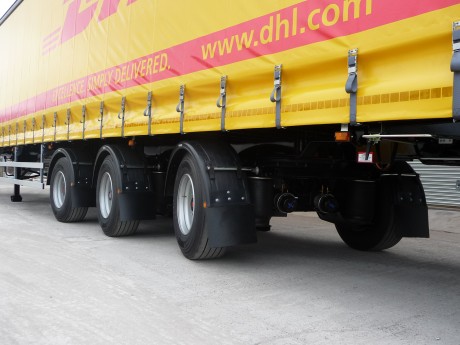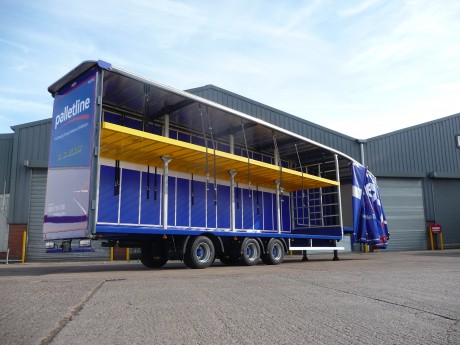
LSTs (Longer Semi Trailers) to Become Legal from 31 May 2023
The DfT has today released a statement saying that "Legislation will be laid today (10 May 2023) to safely roll out the vehicles on roads from 31 May."
The news came amidst a number of industry rumours in 2022 that the legalisation of LSTs was imminent.
After liaising with the DfT, SMMT and VCA, Don-Bur is now in a better position to understand the impact of the announcement.
The trial has been productive in terms of operational feedback and a number of factors from the trial data have been key to the way in which LSTs are to be generally accepted on the UK roads.
With the above in mind, the DfT are amending the current Road Vehicles (Authorisation of Special Types) (General) Order 2003, commonly known as STGO. Many will know STGOs as a method to move heavy and oversized freight but its scope is actually far wider. In this case, LSTs are to be added to the regulations as a separate group (a new article 57) and provide the mechanism to add certain caveats when operating them.
"Operators will be legally required to ensure appropriate route plans and risk assessments are made to take the unique specifications of LSTs into account. In addition to these new legal requirements, operators will also be expected to put in place extra safety checks including driver training and scheduling, record keeping, training for transport managers and key staff, and loading of LSTs."
The target date for the legalisation of LSTs is effectively the 1st June. Once passed, new LSTs will automatically fall within the new statutory regime. Interestingly, trailers falling within the scope of the existing LST trial will continue to be bound by the terms of the trial until they are manually "migrated" to the new regime. Operators with LSTs under trial should not assume that their LSTs will automatically be approved for general use and should continue their "Operator Undertaking". This will provide a transitionary period which is expected to last for 6 months.
The Legal Context
Part II of the Road Traffic Act 1988 (c.52) (“the 1988 Act”) provides for the construction and use of vehicles and their equipment. Section 41 of the act enables provisions with respect to the length of road vehicles.
The Road Vehicles (Construction and Use) Regulations 1986 (as amended), made under section 41 of the 1988 Act (Regulation) provides for the maximum lengths of road vehicles.
Section 42 of the 1988 Act makes it an offence to contravene or fail to comply with the requirements under section 41.
Section 44 of the 1988 Act allows for orders to be made authorising the use of certain vehicles and trailers that do not comply with regulations made under section 41 of the 1988 Act. The DfT considers that LSTs fit these descriptions.
Orders made under section 44 may be subject to specified conditions and restrictions. Where vehicles are used in accordance with such an order, regulations made under section 41 do not apply to them.
The new Statutory Instrument amends The Road Vehicles (Authorisation of Special Types) (General) Order 2003 to make provision for the general use of LSTs on roads as special type of vehicle, subject to specified authorisation requirements as follows:
- Restriction of use of LSTs to routes specified on a route plan and for which a risk assessment has been completed.
- Copies or route plans and risk assessments to be kept for 2 years beginning with the date the LST was last used on the relevant route, and in the towing vehicle whenever the LST is used on the route.
- For monitoring and evaluation purposes, there is a requirement for an operator of an LST to notify the Secretary of State of their intention to use that LST on a road before it is first used by that operator, which will apply for an initial five-year period after the order comes into force.
At the time of writing, it is understood that route planning and notification will be done via the VOL operator licencing system.
LSTs will be subject to all the rquirements of the 1986 Regulations apart from those relating to length and turning circles. They will also be subject to the Road Vehicles (Authorised Weights) Regulations 1998, the Road Vehicles Lighting Regulations 1989 and the Goods Vehicles (Plating and Testing) Regulations 1988.
The Definition of LST Length
Due to the nature of trailer manufacture, there is naturally a difference in overall trailer length depending on whether it is a box van or curtainsider. For standard length trailers, this is defined as a maximum of 12m from kingpin to rear of trailer and a maximum forward swing radius from the kingpin of 2.024m. For LSTs, this has been defined as follows:
- The longitudinal distance from the axis of the kingpin to the rear of a longer semi-trailer must not exceed 14.05 metres.
- The distance parallel to the longitudinal axis of the longer semi-trailer from the foremost part of the loading area to the rear of the trailer must not exceed 15.65 metres.
- The overall length of an articulated vehicle which includes a longer semi-trailer must not exceed 18.55 metres.
Construction Requirements
LSTs must:
- have 3 axles (one of which must be steered)
- have an on-board weighing device where the GVW exceeds 38,000kgs
- not have any load with a rearward projection
The History
LSTs are described as being up to 15.650m long, 2.050m longer than the current maximum legal length under Construction & Use Regulations. A trial started in the UK in 2012 for 900 x 14.6m long and 900 x 15.650m long variants. The original trial length was to be 10 years.
Gross Vehicle Weight was not to be increased under the terms of the trial. As LSTs are bigger and have a greater unladen weight, this has a negative impact on maximum payload weight; a fact that many operators may find limiting.
The trial was then amended in 2017 to permit a further 1,000 LSTs to the trial data set and allow either 14.6m or 15.650m variants within the updated total quantity of 2,800. The trial length was also extended to 15 years which means that the current trial was destined to end in 2027.
The DfT consultation on LSTs formally closed on 1st Feb 2021 and the department was considering the safety data and potential caveats to any legal rollout on UK roads.
Please bookmark this page to keep abreast of updates.
- DfT Press Release: https://www.gov.uk/government/news/uk-economy-boosted-by-14-billion-as-longer-lorries-roll-out-on-roads
- Visit the Don-Bur LST product page
Edit date: 12 May 2023
We’d love to hear from you – get in touch today!






